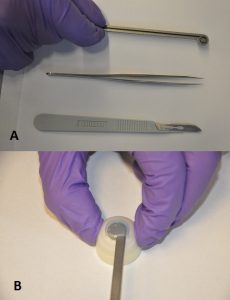Cataracts are a leading cause of vision loss worldwide. In the world’s more developed countries, laser is commonly used for cataract removal. However, in much of the developing world, lasers are expensive or difficult to acquire. In these countries, cataract surgeries are still largely performed freehand, with all of the attendant risks that such procedures involve.
One of this year’s senior design projects in the Department of Bioengineering at Penn was a surgical tool for ophthalmic surgeons to perform capsulorhexis, the fancy term for the circular incision necessary to remove a cataract. The team, which included seniors Akshatha Bhat, Nimay Kulkarni, Steven Polomski, and Ananya Sureshkumar, collaborated with the Aravind Eye Hospital in Puducherry, India, created a surgical device called the Rhex to create this round incision

The Rhex (right) consists of a stem with a ring at the end, into which a blade is fitted. It can be inserted into a scleral incision, pressed, and rotated to perform the capsulorhexis. Initial testing indicated the Rhex could create a circulation incision approximately 6.7 mm in diameter, with eccentricity (indicating deviation from a perfect circle) of 0.254±0.08, which was within the acceptable range determined by the team.
The students designed the Rhex to be autoclavable and to use disposable blades. The next step will be to decrease the size of the instrument further and perhaps to use translucent or even transparent material to produce newer prototypes, which could be particularly useful, since cataract surgeries are open performed using backlighting.
